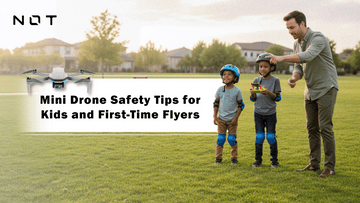If you’ve just unboxed your very first mini drone, or you’re thinking about getting one for yourself, you’re in for an exciting experience. Flying a drone can feel amazing, after all, the world looks so much different from that height. But here’s the catch: while drones are fun, they also need to be handled with care. Especially if it’s your first time, you’ll want to avoid common mistakes that can quickly turn excitement into frustration or unnecessary costs.
That’s exactly why we put together this guide. Drawing on years of experience (and learning from our own blunders), this is your go-to manual for flying safely. If you’re checking out Indian drone suppliers to buy your first quad-copter or testing your shiny new NOT ORO Drone 2K Ultra HD Camera with 2-axis gimbal, these safety tips will help you fly smarter, safer, and with a lot more confidence.
1. Read the Manual Thoroughly
We know what you’re thinking: “Manuals are long and boring.” And yes, they often are. But here’s the fact: you’ll find a ton of important information in them that can save you from making rookie mistakes. Here at NOT drones, with every purchase, we provide live demonstration sessions to make your start-up simpler. If you’ve lost your manual, don’t worry; the information on our official website can help you through it.
The manual will tell you how to set up your drone and what to do if something doesn’t look right. Think of it as the cheat sheet that prevents your mini drone from turning into a very expensive paperweight.
2. Always Check Your Propellers and Motors Before Flight
Propellers are the wings of your drone. Before each flight, check them carefully. Cracks, chips, or bends may seem minor, but they can cause big problems once they’re in the air. For mini drones, especially quadcopters with four propellers, losing even one mid-flight means an instant crash.
Also, take a quick look at the motors. Are they running smoothly? Any strange noise or vibration could mean trouble. Spend a minute on this, and you’ll save yourself hours of frustration later.
3. Test Your Controls Before Takeoff
After takeoff, don’t zoom straight into the sky. Instead, test the basics: forward, backward, left, and right. This simple check lets you know if your mini drone is responding correctly. If something feels off–say, a propeller is wobbling, land immediately.
4. Don’t Fly Indoors (At Least at First)
This is the classic mistake of first-time flyers: taking their new drone for a spin inside the house. Sure, it sounds fun until you clip the ceiling fan or smash into a TV screen. Mini drones may look small, but they can still cause damage or get damaged themselves.
Instead, take your drone to an open, safe area. A field or clearing with no trees or wires is perfect. Once you’ve mastered outdoor control, you can experiment with indoor flying in larger, obstacle-free rooms.
5. Treat Your Batteries with Care
Here’s something many new flyers don’t realize: batteries are driving your drone. Never let them discharge completely, and don’t store them empty. A fully discharged battery loses life quickly and might fail altogether.
The golden rule? Charge your battery after each use. Batteries will automatically discharge to a safe “storage mode” after a week or so. Keep them indoors at room temperature, ideally at about 50–60% charge if you’re not flying for a while.
Pro tip: Keep the battery aside when the drone isn’t in use. It’s a small step that makes a big difference.
6. Weather Matters, Especially Temperature
Cold weather and batteries don’t mix well. As the temperature drops, so does battery performance, meaning shorter flights. And don’t forget about wind, it’s stronger at higher altitudes than on the ground.
So, if you’re taking your mini drone out on a winter day, plan for shorter flight times and keep an eye on how it’s handling gusts of wind.
7. Choosing a Safe Takeoff Spot
Your launch pad matters. Avoid balconies, under trees, or tight spaces. If your drone loses signal, you want it to land safely, not crash into a railing or roof.
Flying over water? Be extra careful. Boats shuffle around, and water reflects light, which can confuse your drone’s vision sensors.
8. Practice Emergency Scenarios
A good flyer is a prepared flyer. Drones like the NOT ORO have GPS to stay stable, but what if you lose that connection? That’s why you should always fly the drone in an open area to ensure your drone has established a strong GPS link.
It’s also smart to practice emergency landings. That way, if something unexpected happens, you won’t panic; you’ll know exactly what to do.
Final Thoughts: Fun, Safe, and Smart Flying
Flying a mini drone is one of the most exciting hobbies you can pick up. It’s fun for kids, beginners, and even professionals who just want to enjoy a casual flight. But safety should always come first. From checking your propellers to respecting the limits of your battery, each step in this guide is designed to keep your drone in the air—and out of trouble.
So, whether you’re browsing drone suppliers in India for your first drone or already holding one in your hands, remember: the sky is yours to explore, but only if you fly safe.
Happy flying!




